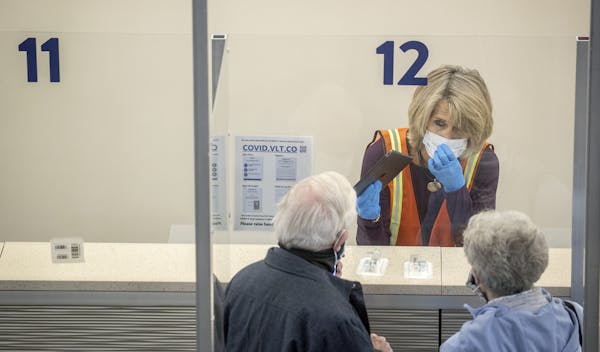A fresh wave of COVID-19 infections in Minnesota is sending record numbers of patients to the hospital as families are finalizing their plans for Thanksgiving gatherings.
With the holiday fast approaching, the escalating COVID-19 crisis has families and medical experts debating the merits of different strategies — including testing, isolation and abstaining from gatherings — to make Thanksgiving and other upcoming holidays safer.
On Sunday, the Minnesota Department of Health added 7,559 cases of COVID-19, bringing the state's overall tally of cases to more than 223,500. About 12% of the 63,600 tests reported Sunday were positive.
More than 2,900 people in Minnesota have died from COVID, including 31 deaths added Sunday.
It was the second weekend in a row with more than 10,000 new cases in Minnesota. November has already seen more confirmed cases of the viral respiratory illness than in March, April, May and June combined.
The rate of people being admitted to the hospital for COVID in Minnesota has never been higher. There were 159 new admissions to the hospital reported on Sunday, while three people were admitted to intensive care. The state has about 300 open ICU beds, and 400 more on 72-hour standby, but the openings are distributed unevenly. Some hospitals already activated backup ICU beds, state data show.
For Todd Lind, a nurse anesthetist in Duluth and father of three adult kids, the surge in COVID patients at work convinced him it was necessary to call off the family's Thanksgiving dinner. In one shift last week, he helped intubate three COVID patients — a personal record.
"Out of an abundance of caution, we decided not to [gather] this year," Lind said. "I'm sure we'll do a FaceTime call or something. But we're all going to have Thanksgiving at our homes."
St. Luke's Hospital, where Lind works, put a temporary pause on scheduling elective surgeries last week amid a sharp rise in cases.
Dr. Rahul Koranne, CEO of the Minnesota Hospital Association, said hospitals across the state have been delaying surgeries in recent weeks, since community spread of the virus has led to staff shortages at the same time that COVID patient counts are peaking. One in four patients in intensive care in the state has COVID.
While hospital beds may still be open, the rise in COVID cases is sending health care workers into isolation like everyone else, creating staffing shortages.
Tips for safe Thanksgiving
As case counts skyrocket, public health experts say the safest way to celebrate Thanksgiving in person is only with immediate household members.
Gov. Tim Walz issued orders limiting gatherings to 10 people from no more than three households. He acknowledged that police likely won't be busting up turkey dinners, but he urged Minnesotans to think long-term.
"If you bring in those extra people, you have exponentially increased the risk," Walz said last week. "If you want to watch football games, if you want go to the theater, if you want to play darts at the bar, sing karaoke, if you want to do all that, then you have to beat the virus first."
Yet government officials and doctors know that family gatherings are bound to happen. Failing abstinence, Thanksgiving celebrants can take the basic steps to make their time together safer: wearing a mask while indoors, staying 6 feet from people outside your household, washing hands frequently and staying away from gatherings if you have COVID or flu symptoms.
Last week state officials encouraged Minnesotans between ages 18 and 35 to get a COVID test before Thanksgiving. Testing alone doesn't eliminate the risk of transmission, partly because COVID tests fail to detect a small number of active cases, especially if transmission occurred only a few days before.
No guarantees
"You'll never be able to get a badge that says, 'I tested COVID-free, so now I can hang out with my grandparents and be completely sure that I'm not going to infect them,' " said Dr. Bobbi Pritt, head of Mayo Clinic's clinical microbiology division.
Also, a test today can't predict if someone will get infected tomorrow. One way to greatly reduce the risk of having COVID on a specific day, like a holiday, is to observe a strict two-week quarantine beforehand and then get tested a few days before the event.
But Thanksgiving is already less than a two-week incubation cycle away. And it's difficult to know whether other people at a holiday gathering will be as diligent about quarantining — or as honest about feeling symptoms.
"What you don't know is, what has everybody else been doing?" said Dr. Tim Schacker, vice dean of research at the University of Minnesota Medical School. "Have all of them had the same definition of what it means to isolate or quarantine? ... Have they truly been asymptomatic? It strikes me that you are not going to test your way out of these questions."
Meanwhile, folks like Lind in Duluth are making difficult choices to break family holiday traditions this year while staying optimistic about future Thanksgivings.
"Hopefully it's a one-year thing," Lind said. "I think with a vaccine on the horizon, and better understanding, we will have better control [of COVID] by this time next year — or hopefully before."
Joe Carlson • 612-673-4779

Want to share info with the Star Tribune? How to do it securely

'Safe recovery sites' would offer syringes, naloxone and more to people using drugs. The plan could be in peril.
New Minnesota GOP leaders seek peace with party's anti-establishment wing

Who is Republican Lisa Demuth, Minnesota's first House speaker of color?

